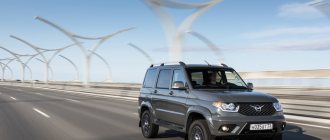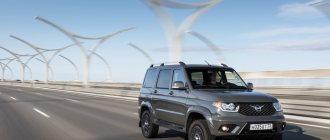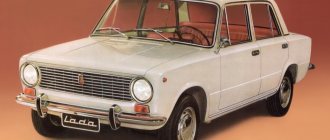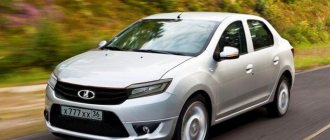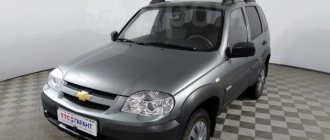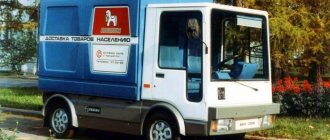Modifications of the short-wheelbase Niva
VAZ-2121 "Niva"
VAZ-2121 “Niva” (export name Lada Niva 4×4) - the base model with the VAZ-2121 engine (1.6 l, 75 hp, 116 Nm) and 4-speed. Checkpoint. Several prototypes of the VAZ-E2121 were created in 1972-1975. At the end of 1976, a pilot production batch of Niva was produced. The model was serially produced from April 1977 to 1993.
VAZ-21211 (Lada Niva 1.3)
VAZ-21211 (Lada Niva 1.3) - export modification with the VAZ-21011 engine (1.3 l, 69 hp, 92 Nm). Produced since 1978 for countries with increased taxes on engines with a volume of more than 1500 cm³ (mainly the Benelux countries and Southern Europe). It was in limited demand due to the low torque of the engine off-road and poor dynamics on regular roads.
VAZ-21212 (Lada Niva 4×4)
VAZ-21212 (Lada Niva 4×4) - export right-hand drive modification. Produced in limited quantities, primarily for the English market. It is known about the sale of a small batch of right-handed Nivas to Japan, where Soviet cars had neither previously nor later penetrated.
VAZ-2122.600 “River”
VAZ-2122.600 “River” is an army amphibious vehicle using VAZ-2121 units. In 1976-1985. Several prototypes of the amphibian with a utilitarian sealed open 2-door body were developed. In 1987, a modified model of the VAZ-2122.600 “Reka” passed state tests, but the amphibian was not mass-produced due to conversion.
VAZ-21213 "Taiga"
VAZ-21213 (the original name “Taiga” did not stick) is a restyled Niva model with a redesigned rear part of the body with a lower loading height (a different shape of the rear door and rear lights), a more powerful and high-torque VAZ-21213 engine (1.7 l , 81.8 hp, 125 Nm) with a Solex carburetor and a contactless ignition system (both reduce fuel consumption), an aluminum radiator, and much more. In 1993, a transitional batch was produced with a standard VAZ-2121 engine.
VAZ-21214 (LADA 4×4)
VAZ-21214 (LADA 4×4) - modification of model 21213 with the VAZ-21214 engine (1.7 l, 81.8 hp, 127.5 Nm) equipped with central fuel injection. Since 2002, this model has been equipped with a VAZ-21214-10 (Euro-0) engine with distributed fuel injection, upgraded in 2006 to Euro-2 (21214-20) and in 2008 to Euro-3 (21214- thirty). Since 2006, in accordance with the agreement on the GM-AvtoVAZ joint venture, it was renamed LADA 4x4 3-door..
VAZ-21215
VAZ-21215 is an export version with a Peugeot XUD 9SD diesel engine, produced in 1999-2007. The modification was produced in small series for export, so the standard assembly included an improved body kit (bumpers, spoilers, linings, alloy wheels, etc.).
VAZ-21216
VAZ-21216 is an export version of model 21213 with right-hand drive and a VAZ-21213 carburetor engine.
VAZ-21217
VAZ-21217 is an export version of model 21213, with a VAZ-21011 engine (1.3 l).
VAZ-21219
VAZ-21219 is a transitional combined modification with a body and suspension from the VAZ-2121 and a 1.7-liter engine and transmission from the VAZ-21213. The interior and rear window washer reservoir were also retained from the VAZ-2121. Produced in 1993-1994.
VAZ-2121B
VAZ-2121B is an armored cash-in-transit vehicle based on the VAZ-2121. It was created in 1992 by specialists from the VAZ subsidiary. Produced in limited edition in 1992-1993. Served as the starting point for the creation of the BRONTO Force family of armored vehicles.
VAZ-2121F
VAZ-2121F is an export commercial version based on the VAZ-2121 and 21213 models with a van-type body. The rear of the cabin has been converted into a cargo area by replacing the side windows (retained on the tailgate) with metal panels and removing the rear seat and trim. Tubular protection is installed behind the front seats to prevent cargo from shifting during braking. The van version of the Niva is manufactured in small batches at the AvtoVAZ production plant for delivery exclusively to the markets of non-CIS countries, where local legislation provides tax incentives for such commercial vehicles.
LADA 4x4M
LADA 4x4M is a modernized version of the VAZ-21214, the gradual development of which is expected from 2009. Lighting devices, interior, transmission components have been changed. Some components were used from Chevrolet Niva.
South Korean Americans
Residents of Russia and Europeans, when asked which country produces Chevrolet cars, give a clear answer: Korea.
This is quite natural, since the lion's share of cars currently sold on the Russian and European markets are indeed assembled on South Korean assembly lines and are essentially nothing more than a continuation of the line of budget cars that existed under the auspices of the Korean brand Daewoo.
The most popular and well-known models to our consumers bore and continue to bear the names Matiz and Nexia.
Although about 3 years ago, an economy plus class model was added to the budget economy class cars - the Chevrolet Lacetti, which received a new life after a slight facelift under the name Daewoo Gentra.
That is, the Chevrolet manufacturer is striving to expand into the Russian and European markets beyond the already familiar economy class, gradually accustoming the consumer to the fact that more expensive, and, therefore, comfortable and powerful cars are also available for sale.
What kind of cars from the Chevrolet brand are available on the Russian market today?
Budget small cars Spark, Cobalt, Lanos and Aveo (assembled in Korea) - Comfort class sedan - Chevrolet Cruze, crossover Captiva and family minivan Orlando (also of the South Korean brand Daewoo) - Niva Chevrolet - these are already products of a joint venture based on OJSC AvtoVAZ - I finally, the true ancestors and pearls of the brand - the famous Camaro, famous not only among consumers, but also on movie screens, the legendary Corvette model - a sharp and impressive sports car, and the classic American Malibu sedan. — Regarding the heavyweights, these are the TrailBlazer and Tahoe - American jeeps with huge engines and external dimensions. By the way, “Tahoe” is the official car of the Secret Service under the President of the United States, which in itself sounds like an impressive recommendation.
So you don’t have to ask car dealership managers questions “where are Chevrolet Lanos, Captiva or Orlando assembled?” Now you definitely know that they are collected in South Korea.
We also note that cars assembled in the USA are strikingly different from cars of Korean or Russian origin. Everything is completely different, of a different quality, of a different level, and of course at a different price.
Do not under any circumstances refuse a test drive and remember that the hallmark of Chevrolet, that very original American one, has always been and remains heavy jeeps - TrailBlazer and Tahoe - try it yourself and we assure you, you will like it!
Extended varieties of "Niva"
VAZ-212180 “Fora”
VAZ-212180 “Fora” is a version of model 21213 extended by 300 millimeters. It was produced in small series from 1996 to 2005 (VIN code “X7G”). It differs from the base model in having wider doors and doorways, a raised rear roof due to a plastic superstructure and a wider rear three-seater seat type 2108. The standard equipment of the Fora includes an automatic fire extinguishing system in the engine compartment from the Force armored car, and surcharge - power steering, air conditioning and a plastic guard in front of the radiator grille. Due to the use of wheels of increased diameter (alloy wheels made from Togliatti with Nokian HRC tires), the spare tire is moved out of the engine compartment and secured above the rear bumper.
VAZ-212182 “Force”
VAZ-212182 “Force” is an armored cash-in-transit version of the VAZ-21218 model. In addition to the reservation system, it is additionally equipped with an automatic fire extinguishing system in the engine compartment and an explosion-proof fuel tank; additional battery, air conditioning, remote control of the right door lock from the driver's seat. An armored floor, beacons, etc. are offered as additional equipment. Since the Force is 430 kg heavier than the Fora, suspension springs made from a rod of increased diameter and reinforced shock absorbers are used.
VAZ-212183 "Landole"
VAZ-212183 “Landole” is an open beach SUV based on the “Fora” with a body type “Lando” or “Landole”. SPA BRONTO has been produced to individual orders since 1997. The absence of part of the roof and door pillars is compensated by an original load-bearing tubular frame, onto which, if necessary, a lightweight awning is attached or brackets are mounted for transporting large-sized sports equipment. The tailgate hinges on horizontal hinges. The interior is easy to clean (the seats are covered with leatherette, the floor is covered with soft linoleum). The exterior is complemented by an original plastic body kit and two-tone paint.
VAZ-2129
VAZ-2129 (unofficial name “Cedar”) is a model extended by 500 mm based on the standard VAZ-21213. “Kedr” was created in the early 90s as a carrier of units for the promising minivan VAZ-2120, but in 1992-1994. Produced in a small series at AvtoVAZ OPP. The body was lengthened due to the central insert. Served as the basis for the creation of the 5-door VAZ-2131 model.
VAZ-2129 “Utiliter”
VAZ 2129 “Utiliter” is a commercial modification of the “Cedar”. It differs from the base model in the absence of a rear seat and rear side windows barred from the inside. It was produced individually to order at AvtoVAZ OPP and was not distributed.
VAZ-2130
VAZ-2130 (“Cedar”) is a modification of the VAZ-2129 with a modified interior layout. The three-seater rear seat of type 2108 is moved forward. According to unverified information, the model index was subsequently changed to 2129-01. The VAZ-2130 was produced in small batches in 1993-1994. Served as the basis for the creation of the 5-door model VAZ-2131-01.
VAZ-2131 (LADA 4×4 5-door)
VAZ-2131 (LADA 4×4 5-door) is a five-door model extended by 500 mm based on VAZ-21213 units. Produced at Pilot Industrial Production of AvtoVAZ (OPP AvtoVAZ) since 1993. The VAZ-2131 was created on the basis of the 2129 Kedr model by adding a rear pair of doors. As of February 2009, 100 thousand VAZ-2131 have already been produced, which makes this model the second most popular in the old Niva family. The body is lengthened due to a central 500 mm insert into the standard body of model 21213. Accordingly, the wheelbase and length of the car change. On version 2131, the distance between the front and rear seats is increased by 125 mm, and on version 2131-01 a three-seater rear seat type 2108 is used. The fuel tank is increased to 70 liters. With the development of production of VAZ-2130 engines (1.8 l, 84 hp, 132 Nm) in the OPP, version 21312 with this engine was produced. Due to its characteristic appearance and the love of its manufacturers for the color green, the VAZ-2131 was popularly nicknamed the crocodile.
VAZ-2131 SP
VAZ-2131 SP (213105/213145) is a model manufactured at the VAZ EPP of an ambulance based on the VAZ-2131. It features a rear overhang increased by 300 millimeters and a high plastic roof. Thanks to the increased trunk volume, it allows you to transport a patient on a stretcher and two accompanying doctors with a set of equipment.
VAZ-213102
VAZ-213102 is a “civilian” 5-door version of the sanitary model VAZ-213105 manufactured at the VAZ OPP. It had the same rear overhang increased by 300 millimeters and a high plastic roof, but was equipped with a conventional 5-seater interior. The trunk, increased to 1900 liters, made it possible to place two additional seats in it, which turned the car into a 7-seater (and transferred it to the class of mid-size SUVs). VAZ-213102 was produced to order in 1999-2003.
VAZ-2121 sugar-1
VAZ-2121 Sahara-1 - The Niva’s small-sized interior made us think about lengthening the car. At the end of the 80s, some enthusiastic designers tried to go this route at the plant itself. These are the enthusiasts who created six copies of the elongated Niva with an increased roof height in 1991. Some of the cars from this batch, registered as homemade, fell into private hands, and some were bought by Lada Bank as official ones and registered under their own name “Sahara”. Subsequently, developments on this car were used to create extended versions of the VAZ-2129 “Cedar” and VAZ-21218 “Bronto”.
Two sides of the coin in offers under one brand
If we are talking about the expensive and successful Chevrolet brand, it has two completely different incarnations. The North American side of this company is the creator of unique SUVs with excellent potential and excellent sports cars, supercars with enormous value and premium sedans. But the Chevrolet division is also present in South Korea, where this brand produces mainly former Daewoo models in the budget segment.
This gives General Motors Corporation certain advantages:
- the ability to offer the market a variety of cars in different trim levels;
- entering European markets with budget and quite reliable cars from Korea;
- conquering the CIS market with cheap offers in the budget class;
- testing of technologies for other GM cars and fairly cheap assembly of cars at a Korean plant.
Until 2012, in the markets of the CIS countries, the Chevrolet brand was associated exclusively with cheap and not very high-quality cars, which were bought solely due to lack of money for more impressive vehicles. In turn, in North America, cars under this brand are an expensive and luxury offering that is worthy of purchase.
This brand dissonance has made the Chevrolet company one of the most mysterious in the modern automotive world. This increases interest in the corporation’s proposals. Let's take a closer look at the two different faces of the American corporation.
VAZ-2123 and Chevrolet Niva
VAZ-2123
VAZ-2123 is a Russian compact SUV of the second generation, pilot production batches of which were produced at VAZ in 2001-2002. It maintained continuity with the old Niva in terms of units and received a new, more spacious five-door body. AvtoVAZ did not have the funds to introduce it into mass production, and as a result, the license for the VAZ-2123 and the rights to the Niva brand were sold to the General Motors concern.
Chevrolet Niva (Chevrolet Niva)
American designers made about 1,700 changes to the design of the VAZ-2123, which allowed the Chevrolet Niva to be considered an independent design. Since September 2002, after the launch of a joint production line with General Motors (OJSC JV GM-AvtoVAZ), the VAZ-2123 began to be produced under the Chevrolet Niva brand.
Chevrolet Niva (Chevrolet Niva) FAM-1
The first batch of Chevrolet Niva FAM-1 cars was released in the spring of 2006, production began in November 2006. The car received the VAZ-21236 index and was produced in a single GLX configuration. The car was equipped with an Opel Z18XE engine (1.8 l, 122 hp) and a 5-speed Aisin manual transmission (from Suzuki Grand Vitara), a new transfer case in a single unit with the gearbox. At the end of April 2008, the Chevrolet Niva FAM-1 model was discontinued. In two years, only about a thousand Chevrolet Niva FAM-1 were made and sold.
Chevrolet Niva Trophy (Chevrolet Niva Trophy)
There is a tuning modification “Trophy” (Chevrolet Niva Trophy), adapted for off-road use. The main differences from the basic configuration include a mechanical chain tensioner instead of a hydraulic one, installation of a snorkel to avoid water hammer when passing fords, forced shutdown of engine cooling fans, transmission breathers in the engine compartment, self-locking limited-slip differentials in gearboxes, main pairs with a gear ratio of 4.3 (instead of 3.9) in the transmission, a mechanism for attaching an electric winch.
Chevrolet Niva (Chevrolet Niva), restyling 2009
On March 11, 2009, GM-AvtoVAZ made a long-awaited update to the Chevrolet Niva. The new modification received the VAZ-212300-55 index. The famous Italian design studio “Bertone” was involved in creating the new car design. After the update, the appearance of the car began to correspond to the unified corporate style of Chevrolet, while the manufacturer retained the parameters of geometric cross-country ability.
Manufacturing or assembly?
A full answer to the question that we want to examine today will require a fundamental determination of what is meant by the concept of “production”?
AvtoVAZ, with its OAT group of companies from satellite factories, was the only enterprise in the world that produced auto components and carried out their further assembly on its own conveyor belt. As a consequence, there is a complete lack of need to conduct a dialogue with component suppliers about the economic component, about the advisability of at least periodic production audits, and as a natural result, hundreds of defective parts, which were then installed on cars that had already set the whole country on edge with its unreliability and unpredictability.
Major global brands operate completely differently. The components from which cars are assembled are produced by third-party companies, which are also global brands - take Faurecia, for example - whose plastic products (interior and exterior elements) are used for Ford, Renault, Nissan, and many other brands throughout to the world. Gestamp - steel stamping of body elements, Johnson Controls - relays and switches. Each of these companies has factories on all continents and in almost all developed countries.
Maybe we are about to reveal a terrible secret, but the so-called automaker does not so much carry out production as simply assemble a car on an assembly line from components that were produced by more than one third-party manufacturer.
So it's more about assembly, to be precise in terms.
Other models based on Niva
VAZ-2328 "Wolf"
VAZ-2328 “Wolf” is a pickup truck with a short 2-seater cab based on the VAZ-2131 model. It was supposed to go into production in parallel with the VAZ-2329 pickup truck, but due to low demand, LADA-Tul produced only an installation batch of Volkov.
VAZ-2329 “Bear”
VAZ-2329 “Bear”, “Niva Pickup”, LADA 4×4 Pickup - a pickup truck with an extended 5-seater cab based on the VAZ-2131 model, produced in small series at the VAZ production plant. The car retains its monocoque body (wheelbase 2700 mm) with a reinforced base and has a rear overhang increased by 300 mm. Load capacity is 650 kg. The VAZ-2329 retains the mechanical part from the VAZ-2129/2131. On request, instead of the VAZ 21213 engine, it was possible to install a VAZ-2130 engine (1.8 l, 84 hp). An additional fuel tank is provided, which brings their total capacity to 84 liters. The rear seat in the cabin is original and when folded forms a flat cargo area. The first releases of the pickup truck bore their own name “Bear”.
FVK-2302 "Bison"
FVK-2302 “Bison” is a pickup truck with a frame chassis based on Niva units. A pickup truck with a short double cab and a wooden platform was produced in small series by one of the small Tolyatti companies in 1993-1995. The reinforced rear suspension of the Bison was made with springs from the Volga and a rear axle from the UAZ
VIS-2346
VIS-2346 is a family of pickup trucks with a semi-frame chassis based on Niva units produced in Tolyatti, produced since 1996. Currently, two versions of the pickup truck are produced in small series: VIS-2346 with a short double cab and VIS-23461 with an extended 5-seater cab. Previously, the VIS-23464 pickup truck with a one-and-a-half four-seater cab and the VIS-2348 pickup truck with cabin panels from LADA Samara 2 were also produced. The reinforced rear suspension is made of springs.
BRONTO-1922 “March-1”
BRONTO-1922 “Marsh-1” is a snow and swamp-going vehicle (“pneumatic”) on ultra-low pressure wheels on VAZ-21213 units. It has been produced in small batches by JSC SPA BRONTO since 1997.
Lada 4x4 21214-0000070-20 “Niva Lynx”
“Niva Lynx” is actually a Lada 4x4, even more adapted for off-road driving.
The front suspension travel has been expanded, a spacer has been installed under the upper ball joint and front shock absorbers have increased travel by 25 mm. The travel of the rear shock absorbers has increased by 50 mm. “Lynx” received wheels with 235/75R15 tires with increased lugs. The wheel arches have been modified and rubber arch extensions have appeared.
To increase traction torque, a 4.1 gear pair was installed instead of the standard 3.9. Self-locking differentials are installed in the gearboxes.
One of the first copies of the car belongs to the Prime Minister of the Russian Federation V.V. Putin.
Budget segment from the South Korean Chevrolet plant
In Europe and Russia, when asked about the country of manufacture of Chevrolet, motorists confidently answer - Korea. Indeed, most of the offerings on the market are produced at the Korean Daewoo plant. The Daewoo brand sells the cheapest offers in Russia, Ukraine and some other countries, such as Matiz and Nexia. Since 2014, they have also been joined by a more expensive car - a redesigned Chevrolet Laceti - Daewoo Gentra.
This move by the corporation indicates that the Chevrolet brand is beginning to increase its status in European markets. Today in Europe and Russia the following offers from Chevrolet are available:
- Korean budget Spark, Aveo and Cobalt;
- comfort class Cruze, family minivan Orlando and crossover Captiva also from Daewoo;
- Russian Chevrolet Niva, which is produced by AvtoVAZ;
- the American Malibu sedan and the Corvette sports car, as well as the company’s bestseller, the Camaro;
- the Trailblazer SUV and the large Tahoe jeep, which also come from America.
That is why you need to be as careful as possible when buying a car under an American brand. Car production is carried out in Russia, Korea and America. But the cars that are assembled in the USA are very technically and visually different from the Korean ones. They use different metal, different technologies, completely different interior materials.
If you want to experience all the greatness of American technology, buy the large Trailblazer or Tahoe. These are quite acceptable competitors to premium Japanese crossovers and SUVs. Only in 2015 will the Chevrolet brand in the CIS countries and Europe finally begin to change its nature and transfer to the premium American class.
Let's sum it up
Cars, assembled in virtually every developed country in the world, cannot but attract attention. Chevrolet took several extraordinary steps that helped the company conquer markets. For example, in 2010, the Chevrolet brand became the best-selling brand in Russia and Britain, and in America these cars occupy one of the first lines of the hit parade of successful cars every year.
The peculiarities of the corporation's work suggest that in the near future it will be very difficult for competitors to bypass the company in any direction. I wonder how you personally feel about the entire Chevrolet brand and the philosophy of its global development?
Despite the fact that work on the 2123 project began in the first half of the eighties of the 20th century, at a certain point it became clear to the designers that it would be more expedient to create a new model rather than try to improve the regular VAZ-2121.
Since all the efforts of the factory workers at that time were thrown into putting the VAZ-2108 on the assembly line, they began to seriously engage in the promising off-road passenger car a little later. The official starting point can be considered 1986, when the technical specifications for model 2123 were finally formed and sent to the design departments of AVTOVAZ.
An important feature of the technical specifications for model 2123 was the body type - frame. At that time, this design with hinged plastic panels had both supporters and opponents in Tolyatti. There were already production cars in the world made according to this design - for example, the Renault Espace minivan.
1 / 4
2 / 4
3 / 4
4 / 4
However, the idea of “framing” the Niva was soon abandoned, because this required huge financial costs and a complete re-adjustment of production: in large-scale production conditions, the production of a car with a frame body required the development of new technologies and materials. The power structure had to be made using high-alloy steels, and the front panels required expensive and difficult-to-manufacture plastic. This meant that, despite all the apparent advantages of the frame-panel structure using “eternal” plastic, its serial implementation at that time was impractical.
Crossover Thoughts
In order to test the idea of using a chain drive in a transfer case in practice, VAZ purchased a transmission from a first-generation Mitsubishi Pajero SUV.
As it turned out, to use such a design, the plant would have to purchase a license, as well as eliminate all “technological” issues associated with a radical redesign of the transmission. New driveshafts, pedal assembly, body parts (central tunnel and bottom), exhaust system and much more stopped the designers, forcing them to remain faithful to the “native” scheme, which by that time had already been tested and verified by both professionals and hundreds of thousands of ordinary people car owners.
There were also those at the plant who believed that the new Niva needed to be brought even closer to a passenger car, deliberately worsening its off-road qualities. Moreover, such a “crossover” model could be widely unified with the latest front-wheel drive - the VAZ-2108. Yes, yes, some experts insisted that the engine on the 2123 should be positioned not along, but across the engine compartment!
In order to study the issue in practice, UGC VAZ purchased two “Japanese” cars - Nissan Prairie and Honda Civic Shuttle, which underwent comprehensive tests.
1 / 5
2 / 5
3 / 5
4 / 5
5 / 5
Opinions were divided: some designers believed that the new car could sacrifice cross-country ability in favor of other consumer qualities, while others believed that the Niva-2 should not be inferior to the VAZ-2121 in terms of off-road potential. It is not surprising that the “jeeper” concept was adhered to by those designers, constructors and testers who were directly involved in the development of the first Niva. They just stood up for the “native” scheme and did not allow the compact Togliatti SUV to be turned into a crossover like the Toyota RAV4 or Hyundai Tucson. History does not suggest the subjunctive mood, but Niva, it seems, had the opportunity to enter the same river twice and again be ahead of its time with its concept - this time “parquet”. It didn’t work out - due to the fact that the “twenty-first” showed itself very clearly in terms of off-road qualities, the factory did not dare to give up its main trump card.


